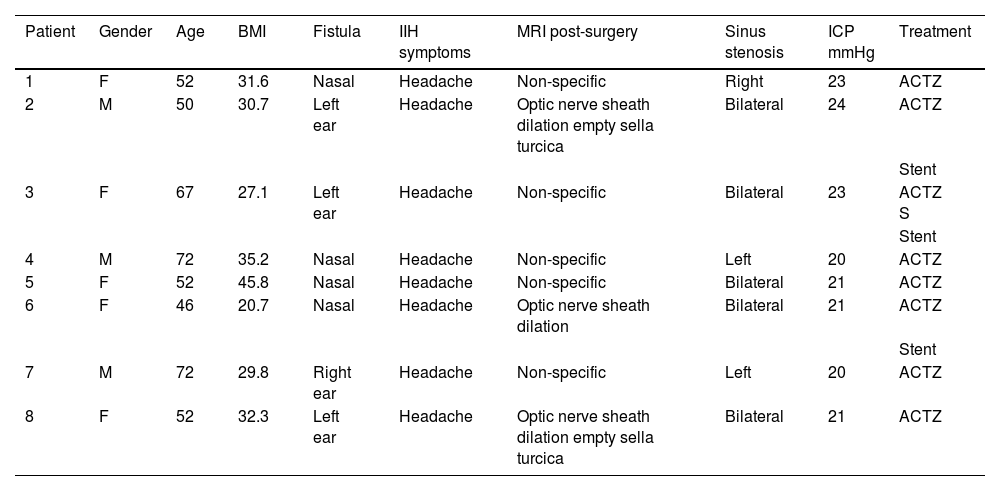Spontaneous cerebrospinal fluid (CSF) fistula, of unknown origin, is a rare condition whose aetiology is increasingly related to idiopathic intracranial hypertension (IIH). This study tries to raise awareness that they should not be considered as two different processes, but that fistulas can be a form of debut, requiring a study and subsequent treatment. Repair techniques are described, as well as the study of HII.
ResultsWe treated 8 patients, 5 women and three men, aged between 46 and 72 years, with a diagnosis of spontaneous CSF fistula, four nasal and four otics who underwent surgical treatment. After repair, a diagnostic study was performed for IIH by MRI and Angio-MRI, presenting in all cases a transverse venous sinus stenosis. The intracranial pressure values obtained by lumbar puncture showed values of 20mm Hg or higher. All patients were diagnosed with HII. The one-year follow-up did not reveal any recurrence of the fistulas, maintaining a control of the HII.
ConclusionDespite their low frequency of both cranial CSF fistula and IIH, an association of both conditions should be considered by continuing the study and surveillance of these patients after fistula closure.
La fistula espontanea de líquido cefalorraquídeo (LCR), de origen desconocido, es una afección poco frecuente cuya etiología se relaciona cada vez más con la hipertensión intracraneal idiopática (HII). Este estudio trata de concienciar que no deben considerase como dos procesos distintos, sino que las fistulas pueden ser una forma de debut, requiriendo un estudio y tratamiento posterior. Se describen las técnicas de reparación, así como el estudio de la HII.
ResultadosSe trataron 8 pacientes, 5 mujeres y tres hombres, con edades comprendidas entre 46 y 72 años, con diagnóstico de fistula espontánea de LCR, cuatro nasales y cuatro óticas a los que se le sometió a tratamiento quirúrgico. Tras la reparación se realizó un estudio diagnóstico para la HII mediante RMN y Angio-RM, presentando en todos los casos una estenosis de seno venoso transverso. Los valores de presión intracraneal obtenidos mediante punción lumbar mostraron valores de 20mm Hg o superiores. Todos los pacientes fueron diagnosticados de HII. El seguimiento a un año no reveló ninguna recidiva de las fistulas, manteniendo un control de la HII.
ConclusiónA pesar de su escasa frecuencia tanto de las fistula craneales de LCR como de la HII, debe considerarse una asociación de ambas afecciones continuando el estudio y vigilancia de estos pacientes tras el cierre de la fístula.
Article

If it is the first time you have accessed you can obtain your credentials by contacting Elsevier Spain in suscripciones@elsevier.com or by calling our Customer Service at902 88 87 40 if you are calling from Spain or at +34 932 418 800 (from 9 to 18h., GMT + 1) if you are calling outside of Spain.
If you already have your login data, please click here .
If you have forgotten your password you can you can recover it by clicking here and selecting the option ¿I have forgotten my password¿.











